What is a road bike?
Characterised by their drop handlebars (mostly) and 700c wheels, with narrow, fast rolling tyres, road bikes are designed for fast and efficient tarmac riding. The drop handlebars allow you to adopt an efficient aerodynamic riding position, while the narrow tyres reduce rolling resistance, both of which are essential for riding quickly and efficiently on the black stuff.
Compared to mountain bikes and most hybrids the range of gears on a road bike is narrower, but the gaps between the gears tend to be closer which makes it easier to achieve your optimum pedalling speed (cadence). We will look into road bike gearing in more detail later.
Ideal for racing, club rides and fitness training, road bikes are also great for commuting.
Are there different types of road bikes?
Catering for different types of cycling, road bikes have diversified into four distinctive types;
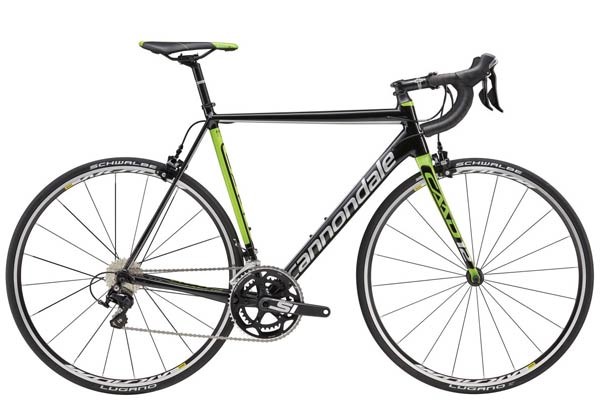
Road race bikes
Featuring an aggressive riding position, with a focus on lightweight and nimble handling. Ideal for traditional road riding these are sometimes known as ‘climbing bikes’ due to their lightweight wheels and frames.
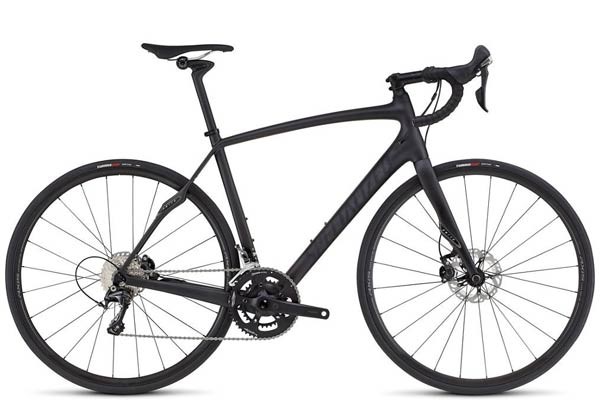
Sportive road bikes
Also known as endurance bikes these were first built to take on gruelling long distance races like the notorious Paris-Roubaix. The riding position is a little more upright and the frame tubes feature engineered compliance (flex) to offer comfort when riding over rough surfaces. Also known as ‘sportive bikes’ these are a little heavier than equivalently priced road race bikes but are more suited to long distance riding on varied road surfaces.

Aero race bikes
Featuring aerodynamic frame shapes to reduce drag, alongside an aggressive riding position, these are the fastest road bikes on flat terrain. Not to be confused with the ultra-aero time trail bikes, aero race bikes can be ridden safely in a group. All the aero enhancements do add weight, so these bikes won’t be as quick up-hill as an equivalently priced road race bike.
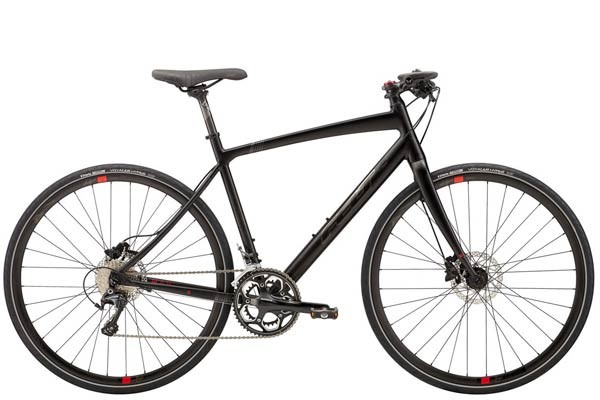
Flat bar road bikes
Designed for urban riding, with road bike frames, wheels and gearing these are the same as regular road bikes with one crucial difference, the handlebars. While offering a less aerodynamic riding position, the flat handlebars provide increased control and visibility making them more suitable for cycling in traffic.
What type of road bike should I buy?
This will depend on the type of riding you intend to do as well as your cycling experience and fitness levels. There are no hard fast rules but the general principles are;

Fitness training & urban cycling
Flat bar road bikes are easier to ride, offer improved visibility and more manageable in traffic. This makes them ideal for new cyclists who simply want to improve their fitness as well as urban commuters.
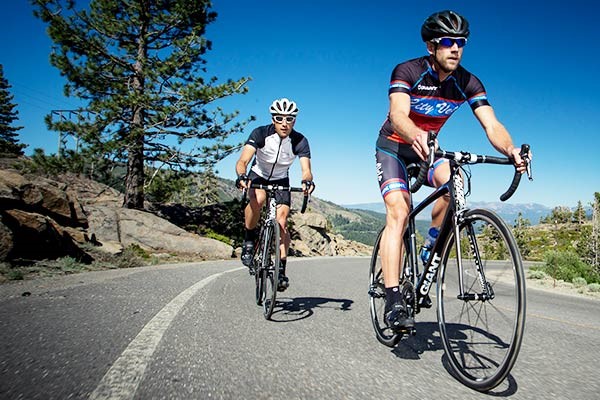
Long distance, rough road & new to road
Sportive road bikes (endurance bikes) are ideal for long distance events such as sportives where the more relaxed riding position and comfort features reduce fatigue. Similarly, new road riders will find the relaxed geometry easier to adapt to.

Club rides & getting more into the sport
Road race bikes offers a more efficient riding position that is preferred by more experienced cyclists. These bikes are a good choice if you want to improve your road cycling or ride with a club.

Racing events & riding faster
Aero road bikes are now the most common type of bikes found in the Pro Peloton. The aerodynamic advantage means that you will be able to ride faster but the ride will be harsher than road race bikes.
Should I buy a flat bar road bike or a hybrid bike?
This will depend on your fitness levels as well as the terrain on your route and how fast you want to ride. The principle difference between a flat bar road bike and a hybrid sports bike is the gearing. Compared to flat bar road bikes, hybrids have a much wider range of gears with larger jumps between them, a good selection of low gears for easy climbing, but lack the very high gear ratios for very fast cycling. This means that, on a flat bar road bike, you can ride faster, will find it easier to match your cadence to you speed but will have to work harder when climbing steep hills.
What should I look for when buying a road bike?
Frame
Aluminium alloy frames are lightweight and robust. As you go up the price points alloy frames tend to get lighter, they may also have compliance (flex) features built in to improve the ride quality. Carbon fibre composites are just as strong but weigh significantly less. The ride quality is much smoother on a carbon bike due to the natural vibration damping properties of the material. Carbon fibre also allows engineers to design in more sophisticated compliance features which offer a very smooth ride without compromising efficiency or handling.
Check our road bike size guide to get the right size for you
Fork
Carbon composite forks offer precise steering control, as well as offering a more comfortable ride, by absorbing road vibrations before they reach your hands. Carbon forks are now found on many alloy bikes.
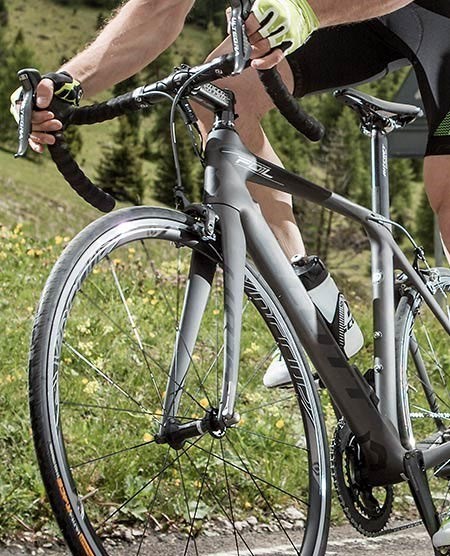

Gears
As you go up the price points the number of gear options increases and the speed, smoothness and reliability of the gear shifts improves. Other than that the two things to consider are the type of chainset and the range on the cassette;
Chainset – compact cranks, with 50 and 34 tooth chainrings, are ideal for new riders as they offer the perfect balance between speed and easy climbing. Chainsets with larger 52 and 54 tooth chain rings will enable you to ride faster but require high levels of fitness when climbing .
Cassettes – wide range 11-32 tooth cassettes make climbing easier but there are wider jumps between each cog. Narrow range 11-28 & 11-25 cassettes make it easier to match your cadence but will make you work harder on the climbs.
Wheels & tyres
As you move up the price points on road bikes the wheels will get lighter. This means that they accelerate quicker and require much less effort when climbing. The exception to this rule is aero wheelsets that sacrifice a little weight in order to slice through the air more efficiently. 23c tyres are the fastest as they offer less rolling resistance, wider 28c tyres are a little slower but offer improved cornering grip and a smoother ride. 25c tyres offer the ideal compromise and are now the most common tyre width on road bikes
Brakes
Traditional calliper rim brakes are still the most common brake type on road bikes. Disc brakes are becoming more popular, especially on endurance bikes as they offer powerful and consistent braking control in all weather conditions. Mechanical disc brakes are found on the more affordable models but some experienced cyclists find these a bit harsh. Hydraulic disc brakes offer improved modulation making it easier to apply just the right amount of pressure for smooth stopping control.

Most popular road bikes
Frequently Asked Questions
A road bike is great for cycling quickly and efficiently on the road. Flat bar road bikes are good for urban cycling while drop bar road bikes are best everywhere else as they offer better aerodynamics.
If you want to get the most benefit from cycling, then it’s worth getting a good road bike as these are easier and more efficient to ride. The fitness and mental health gains easily make it worth the purchase price.
Many people call all road bikes racing bikes as they look like the bikes that pro cyclists ride. True road race bikes tend to have very aggressive geometry while recreational road bikes are a little more relaxed.
If you have good athletic flexibility, then you can be comfortable riding a road bike. Correct bike fitting is crucial to your comfort in the saddle. If a tucked riding position is difficult for you then a hybrid bike will be the more comfortable option.
It may take a little while to get used to the aggressive geometry of a road bike, but once you do you will find them easy to ride compared to other bikes, especially when cycling up the hills.
A good entry level road bike will have a lightweight alloy frame with dual control brake/gear levers. Disc brakes are common now too. See our Best Road Bikes Under £1,000 for more.
A more expensive bike will perform better. An expensive road bike with a carbon frame, wheels and top-of-the range components will be faster than an entry level machine, but not by that much. You can get very good road bikes for under £2,000.
The most important thing is to buy a bike that is the correct size. See our bike size guide. The next thing to consider is what type of riding you will be doing. See our Road Cycling for Beginner’s guide for more.
If you want to ride on rough roads and gravel tracks as well as smooth tarmac, then a gravel bike is best. If you don’t want to venture off road then an endurance road bike is probably a better choice. See our gravel bike guide and endurance road bike guide for more.





